
Loricariidae is the largest family of catfish, with 92 genera and just over 680 species. Loricariids originate from freshwater habitats of Costa Rica, Panama, and tropical and subtropical South America. These fish are noted for the bony plates covering their bodies and their suckermouths. Several genera are sold as "plecos", notably the suckermouth catfish, Hypostomus plecostomus, and are popular as aquarium fish.

Baryancistrus is a genus of freshwater Loricariid catfish. They inhabit flowing sections of rivers, especially clearwater, in the basins of the Amazon and Orinoco in Brazil and Venezuela. The largest species reach up to 34 cm (13 in) in total length.
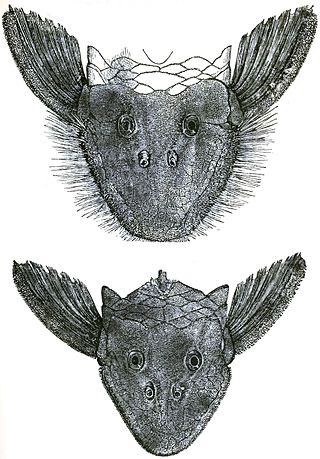
Pseudancistrus is a genus of suckermouth armored catfishes native to South America.

Peckoltia is a genus of small South American armored suckermouth catfishes. Many of these fish are popular aquarium fish.

Hemiancistrus is a genus of suckermouth armored catfishes. These species are native to South America. The taxonomy of this genus is complex and unclear, and major work has to be done. Many of these fish are popular aquarium fish.

The Hypostominae are a subfamily of catfishes of the family Loricariidae. Most members are restricted to tropical and subtropical South America, but there are also several species in southern Central America. Hypostomus plecostomus, which is popular in the aquarium trade, has been introduced to several regions far from its native range.
L200 or L-200 may refer to:
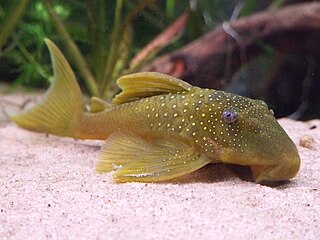
Baryancistrus demantoides is a species of armored catfish endemic to Venezuela. It reaches a length of 15.1 centimetres (5.9 in) SL. It lives around granite rocks in flowing water, in the upper parts of Orinoco River.

Peckoltia sabaji is a species of catfish in the family Loricariidae. It is native to South America, where it occurs in the basins of the Rupununi, the Essequibo River, and the Takutu River in Guyana, as well as the basins of the Casiquiare canal, the Rio Negro, the Cinaruco River, and the Orinoco in Venezuela. It is usually found among boulders in medium to large rivers. The species reaches 19.8 cm SL and is of disputed classification.
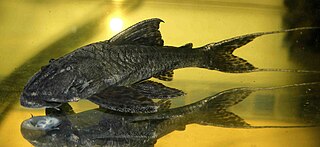
Peckoltia pankimpuju is a species of armored catfish from the family Loricariidae, native to the Marañón River in the upper Amazon basin of Peru. It is commonly called the coal pleco, Peruvian lyre-tail, and L350 under the L-number code. It reaches up to about 40 cm (16 in) in length.
Baryancistrus beggini, commonly known as the blue panaque, is a species of catfish in the family Loricariidae. It is a freshwater fish native to South America, where it is known from Venezuela and Colombia. The species is found in areas with boulders or interstices of granitic bedrock in exposed portions of the Guiana Shield. It is reported to feed on periphyton and microfauna that occur on the surfaces and undersides of rocks in its habitat. The species reaches 8.1 cm SL. Its specific epithet honors Chris Beggin, who supported the research of the species. In the aquarium trade, this species is sometimes known by its L-number, which is L-239.

Baryancistrus niveatus is a species of catfish in the family Loricariidae. It is native to South America, where it occurs in the basins of the Xingu River, the Tapajós, the Trombetas River, and the Tocantins River in Brazil. This species is among the largest members of the genus Baryancistrus, reaching 34 cm in total length. It sometimes appears in the aquarium trade, where it is known by its L-number, L-026.
Hemiancistrus guahiborum is a species of catfish in the family Loricariidae. It is native to South America, where it occurs in the Orinoco drainage in Venezuela and Colombia. The species reaches at least 12.55 cm (4.94 in) SL and was described in 2005 by David C. Werneke and Jonathan W. Armbruster of Auburn University, Nathan K. Lujan of the American Museum of Natural History, and Donald C. Taphorn of the Royal Ontario Museum on the basis of its distinctive coloration and morphology. It appears in the aquarium trade, where it is usually known either as the orange-seam pleco or by its L-number, which is L-106.
Hemiancistrus furtivus is a species of catfish in the family Loricariidae. It is native to South America, where it occurs in the Esmeraldas River basin in Ecuador. The species reaches 9.98 cm SL and was described in 2017 by Francisco Provenzano and Ramiro Barriga of the Central University of Venezuela, who report its placement in the genus Hemiancistrus to be tentative and suggest that it may belong to the tribe Hypostomini rather than Ancistrini, where it is currently placed. As of May 2022, FishBase does not list this species.
Hemiancistrus meizospilos is a species of catfish in the family Loricariidae. It is sometimes known as the southern orange-spotted pleco. The type locality of H. meizospilos is given as the Chapecó River in the vicinity of Coronel Freitas in the Brazilian state of Santa Catarina.
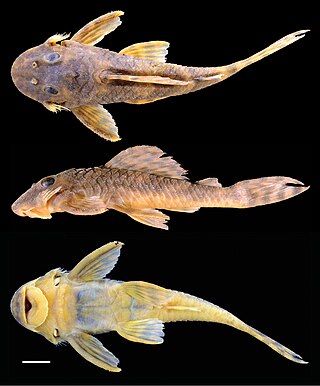
Peckoltia lujani is a species of catfish in the family Loricariidae. It is native to South America, where it occurs in the Orinoco and Meta River basins in Venezuela and Colombia. The species reaches 7.5 cm SL.
'Pseudancistrus' megacephalus is a species of catfish in the family Loricariidae. It is of uncertain and disputed classification.
Hypostomus maracaiboensis is a species of catfish in the family Loricariidae. It is native to South America, where it occurs in the Lake Maracaibo basin in Venezuela. The species feeds on algae and detritus, reaches 28.5 cm in total length, and is believed to be a facultative air-breather. The species was originally described by Leonard Peter Schultz in 1944 as a member of Hemiancistrus, and some sources continue to refer to it as such. In 2015, a taxonomic review conducted by Jonathan W. Armbruster, David C. Werneke, and Milton Tan reclassified it and recognized it as a member of Hypostomus.
Ancistomus snethlageae is a species of catfish in the family Loricariidae. It is native to South America, where it occurs in the Tapajós basin in Brazil. The species reaches 22 cm (8.7 in) in total length. Although originally described as a species of Ancistrus in 1911 by Franz Steindachner and subsequently reclassified in the genera Hemiancistrus, Lasiancistrus, and Peckoltia, a 2015 review conducted by Jonathan W. Armbruster, David C. Werneke, and Milton Tan listed the species as valid within Ancistomus.
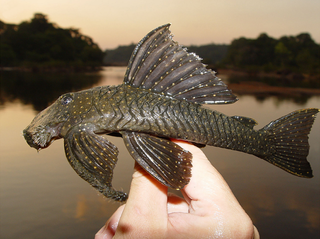
Guyanancistrus niger is a species of catfish in the family Loricariidae that is of disputed classification. It is native to South America, where it occurs in the Oyapock basin in French Guiana. Though reportedly uncommon, it is typically seen in rapids where the species Pseudancistrus barbatus is also present, although the ecological relationship between the two is not known. The species reaches 15.9 cm (6.3 in) in standard length, although it has been reported to reach 25.4 cm, and it may be a facultative air-breather.











